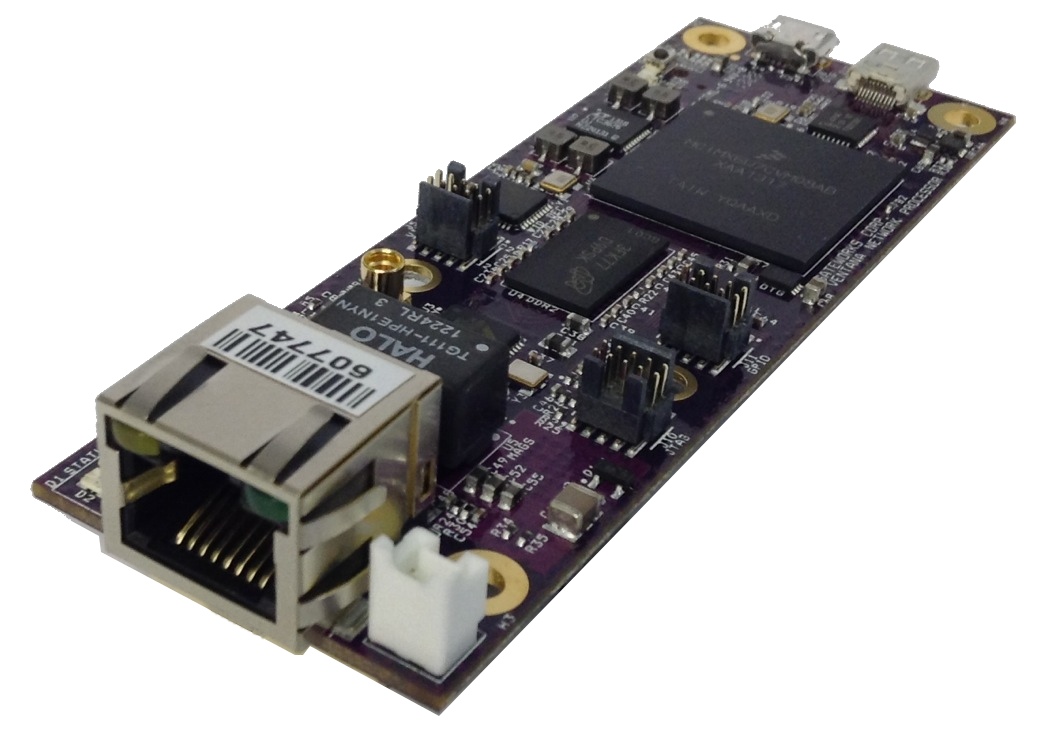| Version 27 (modified by , 2 years ago) ( diff ) |
|---|
Gateworks Venice Family Support
 Getting Started |
Venice Software |
Peripherals |
User Manuals |
|
Wireless / WiFi Radios |
Cellular Modems |
GPS |
 3D Model |
The Gateworks Venice product family utilizes the NXP i.MX8M Mini (i.MX8MM) SoC (System On Chip) family offering a large variety of peripherals with a focus on Networking, Security, and Media. See here for a product comparison matrix.
Links
Please note: This is a subset of information for Venice, however, please visit our Main Wiki for all other information
Software
- Software Section - Bootloader, Boot Firmware, Operating Systems, Kernel, etc
Security
- Venice Secure Boot
- Venice Encryption
- Linux Encryption
- Generic Secure Boot
- TPM / Trusted Protection Module / Security
Peripheral Support
- Connector Pinouts - see Hardware User Manual
- Venice MIPI DSI / CSI - LCD Video Display output / Camera Video Input
- Connector and Cable Information
- Serial Console Access
- USB Support - Note the standard Venice family supports USB 2.0 (USB 3.0 not currently offered)
- SPI Support
- I2C Support
- GPIO Control
- LED Control
- mSATA Information
- GPS Support
- CAN Bus Support
- PCIe Accessory Cards
- MultiMediaCard (microSD/eMMC) Information
- Gateworks System Controller (GSC) - Temperature, voltage, RTC, GPIO, Digital IO, I/O, pushbutton, etc
- TPM / Trusted Protection Module / Security
Other Info
- Product Info
- Where to Buy
- Venice Board Ordering Options
- Venice Board Errata
- Linux Kernel Device-Tree info
- End of Life - EOL Dates
User Manuals
Entire Raw Index of Venice Wiki Pages
- venice
- venice/DigitalIO
- venice/PCIe
- venice/SDP
- venice/SOM
- venice/boot
- venice/bootloader
- venice/bsp
- venice/edgelock
- venice/encryption
- venice/errata
- venice/ethernet
- venice/firmware
- venice/gw7500
- venice/gw7905
- venice/memory
- venice/mipi
- venice/multimedia
- venice/npu
- venice/orderoptions
- venice/power
- venice/secure_boot
- venice/simsd
- venice/thermal
- venice/ubuntu
- venice/yocto
Venice Software
Venice Software is comprised of many pieces, including the following:
- GSC (Gateworks System Controller) Firmware
- Boot Firmware (ARM Trusted Firmware, DDR controller Firmware, U-Boot Bootloader)
- Operating System (including kernel / rootfs)
Ubuntu is pre-installed on all Venice boards before they ship.
Please view the following links for the appropriate software section:
- Choosing an OS - Ubuntu, OpenWrt, Buildroot, Yocto, etc
- Pre-built Software Images and Installation instructions
- Building & Compiling BSP (Board Support Package) Images - This includes all the boot firmware & operating System
- Venice Boot Process and Firmware (up to and including the Bootloader) details
- GSC Firmware
- Venice Mainline Linux kernel support
- Booting Third Party Linux Distro's on Venice
- Venice JTAG Programming
- Native Compile Hello World Example
- Buildroot Linux
Venice Low Power / Sleep Mode
The Venice family has a M4/M7 coprocessor that may allow for low power / sleep functions. Gateworks has not done any testing or software development on the M4/M7 side of things, but you would be welcome to use it. You may find more information on the following links:
- https://www.nxp.com/docs/en/application-note/AN12410.pdf
- https://community.nxp.com/t5/Other-NXP-Products/i-MX8M-MINI-Lop-Power-Mode/m-p/1148737
- https://community.nxp.com/
Choosing a BSP
Gateworks offers several Board Support Packages for the Venice Product family. Which one we recommend depends a bit upon what your goal is and what your experience level is. Note: By default Venice boards are pre-programmed with and Ubuntu root filesystem and Gateworks kernel.
Ubuntu
Gateworks offers a pre-built Ubuntu root filesystem using the latest Gateworks kernel as well as instructions on how to build your own Ubuntu based distribution.
Venice pre-built Ubuntu root filesytem image:
- Recommended for developers trying to heavily leverage opensource software packages or libraries that are not supported by the other BSP's. This is the most user-friendly for developers new to Embedded Linux but will not produce a very trimmed down filesystem image.
- The Gateworks Ubuntu focual image can boot to login in about 26 seconds (removing the U-Boot bootdelay) and takes about 1.5GiB of FLASH storage. Several seconds of that time is spent waiting for the network interfaces to come up which can be disabled. Much of the required space is taken up by various packages we pre-install however it is difficult to get Ubuntu pruned down below 1GiB or booting much faster.
- Able to use mainline kernel.
- Supports all Venice features.
- Documentation provided to use Ubuntu pre-built packages and debootstrap to create a root filesystem in minutes
- Native compilation: no SDK or cross-toolchain needed
Buildroot
Gateworks provides documentation on building your own compact and customized Linux distribution using Buildroot:
- intended for custom applications (low flash and memory footprint)
- a standard buildroot image can boot to login in about 8 seconds (removing the U-Boot bootdelay) and can take less than 32MiB of FLASH storage (both of which can be reduced by turning off the console output and reducing the kernel features)
- Fairly up-to-date and/or vanilla kernel support
- Wide variety of packages
- Console-based build system
- exportable Toolchain available to build apps on a development host outside of the buildroot environment
OpenWrt
- Currently supported on GW71xx, GW72xx, GW73xx. GW74xx with i.MX8M Plus support is coming soon.
- Venice OpenWrt Wiki Page with Downloads
- Intended for wireless routers and access points (low flash and memory footprint)
- Recommended for networking users wanting to create a headless router, VPN, basestation, wireless access point and more. Produces by far the smallest storage and memory footprint but users new to Embedded Linux will have a bit of a learning curve
- Fairly up-to-date and/or vanilla kernel support
- Latest wireless drivers (via linux-backports)
- Custom application config and init system (nice for small footprint, but can make adding support for additional packages more work)
- Wide variety of packages (including a fairly nice web-admin)
- Console-based build system (expect 60mins to build BSP for a specific board family)
- Downloadable SDK and Toolchain available to build apps on a development host without building the entire BSP
- easy firmware upgrade (sysupgrade) and factory-default reset mechanism
- Pre-built images available
Yocto
While Gateworks doesn't officially publish a Yocto BSP, the NXP Yocto rootfs can be used with a Gateworks kernel and a system can be booted. More information is here
Third Party Linux Distros
While Gateworks cannot fully support all Linux distros, it is relatively simple to overlay a Gateworks Venice kernel onto any non-Gateworks third party Linux distro rootfs image.
The following links will describe what is needed:
- Linux kernel supporting Venice: linux/kernel
- Root Filesystem: see below
- Bootable media: linux/blockdev
Root filesystem Sources
There are several sources of pre-built root filesystems that are compatible with Venice. As Venice uses an ARM 64bit based SoC, you need to use something that is compatible with an ARMv8 instruction set. Many pre-built distributions will reference 'arm64' which means 'ARM 64-bit' which is appropriate for the i.MX8MM SoC.
Some popular third-party sources:
- Ubuntu Core - this is a minimal filesystem that you can build off of at runtime by adding packages from various repositories.
- Linaro - Linaro has several root filesystems including server, nano, developer, core, and ALIP. Each root filesystem will have different things installed for different purposes. Choose carefully which will work for you.
Notes:
- some root filesystems may require you to manually add a user before booting (ie Ubuntu Core)
Mainline Linux Kernel support
Gateworks actively participates in the development of the Linux kernel.
The following table shows what i.MX8MM support is available in the mainline kernel:
| item | DT compatible | driver | kconfig | kernel |
|---|---|---|---|---|
| mmc | fsl,imx7d-usdhc | drivers/mmc/host/sdhci-esdhc-imx.c | CONFIG_MMC_SDHCI_ESDHC_IMX | |
| sdma | fsl,imx7d-sdma | drivers/dma/imx-sdma.c | CONFIG_IMX_SDMA | |
| uart | fsl,imx6q-uart | imx-uart: drivers/tty/serial/imx.c | CONFIG_SERIAL_IMX | |
| ethernet | fsl,imx6sx-fec | fec: drivers/net/ethernet/freescale/fec_main.c | CONFIG_FEC | |
| i2c | fsl,imx21-i2c | drivers/i2c/busses/i2c-imx.c | CONFIG_I2C_IMX | |
| spi | fsl,imx51-ecspi | drivers/spi/spi-imx.c | CONFIG_SPI_IMX | |
| gpio | fsl,imx35-gpio | drivers/gpio/gpio-mxc.c | CONFIG_GPIO_MXC | |
| wdog | fsl,imx21-wdt | drivers/watchdog/imx2_wdt.c | CONFIG_IMX2_WDT | |
| pwm | fsl,imx27-pwm | drivers/pwm/pwm-imx27.c | CONFIG_PWM_IMX27 | |
| audio dai | fsl,imx8mq-sai | fsl-sai: sound/soc/fsl/fsl_sai.c | CONFIG_SND_SOC_FSL_SAI | 5.4 |
| caam | fsl,sec-v4.0 | drivers/crypto/caam/* | CONFIG_CRYPTO_DEV_FSL_CAAM | 5.6 |
| ddrc (Dyanmic Scaling for DDR controller) | fsl,imx8m-ddrc | drivers/devfreq/imx8m-ddrc.c | ARM_IMX8M_DDRC_DEVFREQ | 5.6 |
| thermal | fsl,imx8mm-tmu | drivers/thermal/imx8mm_thermal.c | IMX8MM_THERMAL | 5.7 |
| fspi (Flex SPI) | nxp,imx8mm-fspi | drivers/spi/spi-nxp-fspi.c | SPI_NXP_FLEXSPI | 5.7 |
| gpcv2 (power domain) | fsl,imx8mm-gpc | drivers/soc/imx/gpcv2 | CONFIG_IMX_GPCV2_PM_DOMAINS | 5.15 |
| usb | fsl,imx7d-usb fsl,imx7d-usbmisc | drivers/usb/chipidea/{ci_hdrc_imx,usbmisc_imx}.c | CONFIG_USB_CHIPIDEA_IMX | 5.15 |
| blk-ctl (power domain / reset) | fsl,imx8mm-*-blk-ctrl | drivers/soc/imx/imx8m-blk-ctrl | CONFIG_SOC_IMX8M | 5.16 |
| gpu | vivante,gc | drivers/gpu/drm/etnaviv/* | CONFIG_DRM_ETNAVIV | 5.16 |
| mipi csi bridge | fsl,imx7-csi | drivers/staging/media/imx/imx7-media-csi.c | CONFIG_VIDEO_IMX7_CSI | 5.17 |
| vpu/hantro-g1/g1 (mpeg2/h264 video decoder) | nxp,imx8mm-vpu-g* | drivers/staging/media/hantro/hantro_drv.c | CONFIG_VIDEO_HANTRO_IMX8M | 5.18 |
| imx8mm pci | fsl,imx8mm-pcie | drivers/pci/controller/dwc/pci-imx6.c | CONFIG_PCI_IMX6 | 5.18 |
| imx8mp pci phy | fsl,imx8mp-pcie-phy | drivers/phy/freescale/phy-fsl-imx8m-pcie.c | CONFIG_PHY_FSL_IMX8M_PCIE | 6.2 |
| imx8mp pci | fsl,imx8mp-pcie | drivers/pci/controller/dwc/pci-imx6.c | CONFIG_PCI_IMX6 | 6.1 |
| imx8mp pci phy | fsl,imx8mp-pcie-phy | drivers/phy/freescale/phy-fsl-imx8m-pcie.c | CONFIG_PHY_FSL_IMX8M_PCIE | 6.2 |
| mipi dsi bridge | fsl,imx8mp-mipi-dsim | drivers/gpu/drm/bridge/samsung-dsim.c | CONFIG_DRM_SAMSUNG_DSIM | v6.4 |
| imx8mm-venice-gw71xx-0x | dt | 5.12 | ||
| imx8mm-venice-gw72xx-0x | dt | 5.12 | ||
| imx8mm-venice-gw73xx-0x | dt | 5.12 | ||
| imx8mp-venice-gw74xx-0x | dt | 5.19 | ||
| vpu/hantro-h11 (jpeg video encoder) | not yet upstream as of v6.1 |
- While support may not be officially upstream yet, the Gateworks kernel does have support for these devices
See also:
- Prebuilt Venice Kernel: http://dev.gateworks.com/venice/kernel/
- Building the Venice Kernel as part of the BSP: venice/bsp
- Building a Mainline Kernel Wiki: linux/kernel
GW7400 Ordering Options
Attachments (1)
- gw74xxoptions.png (52.2 KB ) - added by 2 years ago.
Download all attachments as: .zip

